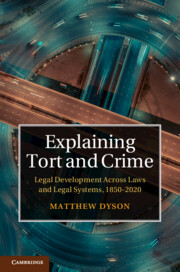Book contents
- Explaining Tort and Crime
- Explaining Tort and Crime
- Copyright page
- Contents
- Foreword
- Preface
- Table of Cases
- Table of Legislation
- Part I Setting the Scene: Introduction and Methods for Explaining
- Part II Mental States and Careless Acts: The Development of Fault Doctrine in Crime and Tort
- Part III Procedures Interfacing Tort and Crime
- 6 Claims and Formats
- 7 Timing Rules
- 8 Criminal Judgments in the Civil Law
- Part IV Conclusions
- Index
8 - Criminal Judgments in the Civil Law
from Part III - Procedures Interfacing Tort and Crime
Published online by Cambridge University Press: 07 July 2022
- Explaining Tort and Crime
- Explaining Tort and Crime
- Copyright page
- Contents
- Foreword
- Preface
- Table of Cases
- Table of Legislation
- Part I Setting the Scene: Introduction and Methods for Explaining
- Part II Mental States and Careless Acts: The Development of Fault Doctrine in Crime and Tort
- Part III Procedures Interfacing Tort and Crime
- 6 Claims and Formats
- 7 Timing Rules
- 8 Criminal Judgments in the Civil Law
- Part IV Conclusions
- Index
Summary
This chapter considers the effect of a prior criminal judgment on a civil court. Depending on your perspective, an earlier criminal judgment might bind, inform, shackle, create risks for or simply be irrelevant to a later civil claim. The chapter builds on the picture from Chapter 6, ‘Claims and Formats’, and Chapter 7, ‘Timing Rules’. Where criminal courts do not compensate, and where civil claims are suspended, convictions will be more relevant.
- Type
- Chapter
- Information
- Explaining Tort and CrimeLegal Development Across Laws and Legal Systems, 1850–2020, pp. 405 - 446Publisher: Cambridge University PressPrint publication year: 2022



